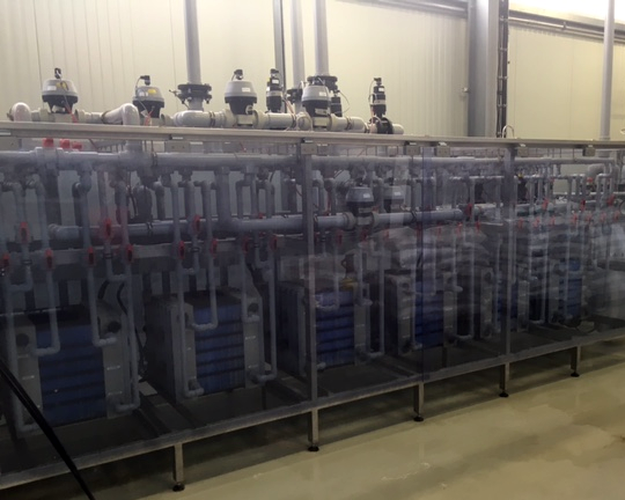Salzfrachtreduzierung von stark salzhaltigem Industrieabwasser mit dem in der Abwasserbehandlung innovativen Verfahren der Elektrodialyse
Einsatzgebiete | Anwendung
- Industrielle Abwasserbehandlung
- Für Abwasser bzw. Abwasserteilströme mit einer Leitfähigkeit ab 50 mS/cm effektiv für Abwassermengen von 50 bis 500 m³/d einsetzbar
- Kombination mit wks-Dosiertechnik möglich
- Modularer Aufbau
- Konzentratbehandlung mit Membrandestillation bis zur Wertstoffrückgewinnung möglich
- Meer- und Brackwasserentsalzung
Produktbeschreibung
Die Entsalzung findet mittels eines elektrochemisch getriebenen Membranprozesses statt. In diesem werden Ionenaustauschermembranen in Kombination mit einer elektrischen Potentialdifferenz zur Teilentsalzung genutzt. Es ist eine abwasserabhängige Realisierung mit Polumkehr möglich, damit in Kombination mit geeigneten Reinigungschemikalien die Reinigung unter Strom erfolgen kann. Verfahrenskennzeichnend ist ein leitfähigkeitsabhängiger, batchweiser Betrieb des Konzentrat- und Diluatstroms sowie eine Elektrodenspülung.
Je nach Abwassercharakteristik erfolgt die Vorbehandlung des Abwassers durch geeignete Filtrationsverfahren. Das Konzentrat (10–20%) wird in einen Konzentratspeicher geleitet. Das Diluat (80–90%) wird der weiteren Behandlung zugeführt. Es erfolgt eine leitfähigkeitsabhängige Regelung des batchweisen Betriebes des Diluat- und des Konzentratstromes. Eine entsprechende Regelungstechnik sorgt für die automatische Reinigung mit abwasserspezifischen Reinigungschemikalien (CIP).
Unsere Leistungen:
- Anlagenpilotierung zur Ermittlung der Eignung des Verfahrens, zur Ermittlung der optimalen Membran sowie zur Auswahl der besten Reinigungsstrategie
- Detailplanung der Verfahrenstechnik, Anlagen- und EMSR Technik
- Realisierung der Komplettanlage
- Inbetriebnahme, Optimierung, Schulung und Service
Konstruktionsmerkmale
- Verfahrensrelevante Ausrüstung zur Vorbehandlung
- Elektrodialytische Ausrüstung
- Membranpakete, CIP
- Automatisierungstechnik
Vorteile
- Energieeffiziente Teilentsalzung
- Je nach Membranauswahl selektive Entsalzung von einwertigen Ionen möglich
- Durch Betrieb mit Polumkehr Erhöhung der Membranstandzeit
- Abwasserspezifische herstellerunabhängige Membranauswahl
- Abwasserspezifische Auswahl der optimalen CIP Rezeptur

